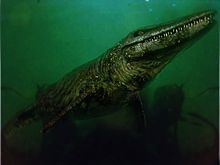Higher classification Mosasaur | Phylum Chordata Scientific name Tylosaurinae Rank Subfamily | |
 | ||
Similar Mosasaur, Tylosaurus, Mosasaurinae, Reptile, Taniwhasaurus | ||
Tylosaurinae is a subfamily of mosasaurs, a diverse group of Late Cretaceous marine lizards.
Russell (1967, pp. 170 ) defined the Tylosaurinae as follows: "Large rostrum present anterior to premaxillary teeth. Twelve or more teeth in dentary and maxilla. Cranial nerves X, XI, and XII leave lateral wall of opisthotic through a single foramen. No canal in basioccipital or basispehnoid for basilar artery. Suprastapedial process of quadrate moderately large, distally pointed. Dorsal edge of surangular rounded and longitudinally horizontal...Twenty nine presacral vertebrae present. Length of presacral series less than that of postsacral series in Tylosaurus, neural spines of posterior caudal vertebrae at most only slightly elongated, do not form an appreciable fin. Haemal arches unfused to caudal centra. Appendicular elements lack smoothly finished articular surfaces."
Genera referrable to the Tylosaurinae (informally and collectively known as "tylosaurines" or "tylosaurs") have been found on all continents except Australia and South America. The etymology for the subfamily is derived from the genus of the type species, Tylosaurus. In general, tylosaurs were large-bodied marine lizards armed with sturdy, conical teeth and an elongated premaxilla and extensions of the dentaries that do not bear teeth to the very end such as is found in other genera of mosasaurs. Cope's original concept of a "battering ram" snout is not supported by fossil evidence. Stomach contents from a tylosaur recovered in South Dakota included remains of another mosasaur, a bony fish, the large, flightless seabird Hesperornis, and possibly a shark, indicating that tylosaurs were generalists. Another specimen collected by Charles Sternberg included the bones of a small plesiosaur (see also ).
Lingham-Soliar suggested that tylosaurines were not among the fastest swimming nor the strongest mosasaurids. However, they are lightly built, having greatly reduced the weight of their bodies and possessing relatively small pectoral and pelvic girdles, fore- and hindlimbs. Their bone is highly cancellous and may have been impregated with fat cells during life, adding buoyancy. These traits suggest that tylosaurs may have been ambush predators. Tylosaurs were among the largest mosasaurs, with some species of Tylosaurus and Hainosaurus reaching lengths of 9-15+ meters, making them among the largest of all marine reptiles. Everhart erected a third species, T. kansasensis, from the Smoky Hill Chalk, but subsequent study has found T. kansasensis to be a growth stage of T. nepaeolicus and therefore the same species.
Polcyn and Bell (2005, p. 322 ) have erected a more inclusive clade, the parafamily Russellosaurina, which includes the "subfamilies Tylosaurinae and Plioplatecarpinae and their sister-clade containing the genera Tethysaurus, Russellosaurus, and Yaguarasaurus."
Tylosaurs first appear in the fossil record in the early Coniacian and persist well into the Maastrichtian, a period of approximately twenty million years.
